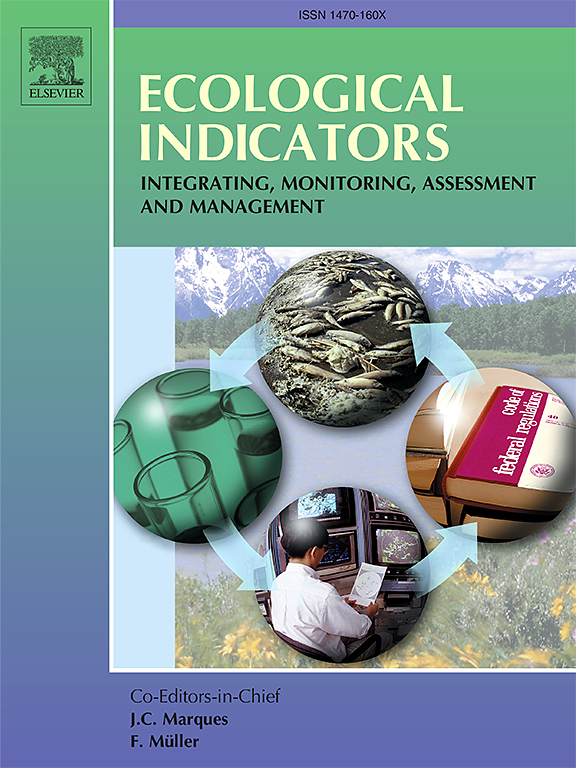Integrating seasonal variation into conservation planning can provide extra benefits: A case study in the Tana River Basin, Kenya
IF 7
2区 环境科学与生态学
Q1 ENVIRONMENTAL SCIENCES
引用次数: 0
Abstract
Seasonal variations in climatic conditions induce spatio-seasonal changes of ecological indicators, such as ecosystem services and biodiversity. However, current conservation planning mostly focus on annual or long-term characteristics of ecological indicators, with limited considerations of their seasonal variations. It remains unclear whether integrating seasonal variation into conservation planning can provide extra benefits. This study examines the Tana River Basin, a typical basin significantly affected by seasonal variations, to integrate these variations into ecological network construction and assess its benefits for conservation. Results demonstrated that integrating seasonal variation indeed improve protection efficiency. Compared to the annual perspective, considering seasonal stability can increase the soil conservation by 82.79 %, water yield by 14.55 % and net primary productivity by 16.78 %, respectively. Meantime, it enables the adjustments of conservation planning based on the seasonal ecological resistance. For instance, compared to long rainy season, the long dry season decreased ecological corridor areas by 33.87 % and increased barrier points by 428.92 %. Accordingly, ecological sources covering an area of 20,758 km2 within the basin were identified in the upper and lower reaches. Ecological corridors were classified into primary and seasonal (Level I and II) corridors to clarify the different priorities. A number of 52 and 22 of hierarchical ecological pinch points and hierarchical barrier points were also identified, respectively. Finally, a “two zones, two axes, five nodes, and multiple corridors” ecological conservation pattern and targeted suggestions for different seasons were proposed. These results provide prioritization information for ecological conservation, supporting for sustainable development of the Tana River Basin.

将季节变化纳入保护规划可以提供额外的好处:肯尼亚塔纳河流域的一个案例研究
气候条件的季节变化导致生态系统服务和生物多样性等生态指标的时空变化。然而,目前的保护规划大多侧重于生态指标的年度或长期特征,对其季节变化的考虑较少。目前还不清楚将季节变化纳入保护规划是否能带来额外的好处。本研究以受季节变化影响显著的塔纳河流域为研究对象,将这些变化纳入生态网络建设,并对其保护效益进行评估。结果表明,整合季节变化确实提高了保护效率。与年稳定相比,考虑季节稳定性可使土壤保持力提高82.79%,水量提高14.55%,净初级生产力提高16.78%。同时,可以根据季节生态阻力对保护规划进行调整。与长雨季相比,长旱季生态廊道面积减少了33.87%,屏障点增加了428.92%。据此,确定了流域上下游生态源面积为20758 km2。生态廊道分为初级廊道和季节性廊道(一级和二级),以明确不同的优先级。鉴定出52个等级生态捏点和22个等级生态屏障点。最后,提出了“两区、两轴、五节点、多廊道”的生态保护格局和针对不同季节的针对性建议。研究结果可为生态保护提供优先排序信息,为塔纳河流域的可持续发展提供支撑。
本文章由计算机程序翻译,如有差异,请以英文原文为准。
求助全文
约1分钟内获得全文
求助全文
来源期刊

Ecological Indicators
环境科学-环境科学
CiteScore
11.80
自引率
8.70%
发文量
1163
审稿时长
78 days
期刊介绍:
The ultimate aim of Ecological Indicators is to integrate the monitoring and assessment of ecological and environmental indicators with management practices. The journal provides a forum for the discussion of the applied scientific development and review of traditional indicator approaches as well as for theoretical, modelling and quantitative applications such as index development. Research into the following areas will be published.
• All aspects of ecological and environmental indicators and indices.
• New indicators, and new approaches and methods for indicator development, testing and use.
• Development and modelling of indices, e.g. application of indicator suites across multiple scales and resources.
• Analysis and research of resource, system- and scale-specific indicators.
• Methods for integration of social and other valuation metrics for the production of scientifically rigorous and politically-relevant assessments using indicator-based monitoring and assessment programs.
• How research indicators can be transformed into direct application for management purposes.
• Broader assessment objectives and methods, e.g. biodiversity, biological integrity, and sustainability, through the use of indicators.
• Resource-specific indicators such as landscape, agroecosystems, forests, wetlands, etc.
 求助内容:
求助内容: 应助结果提醒方式:
应助结果提醒方式:


